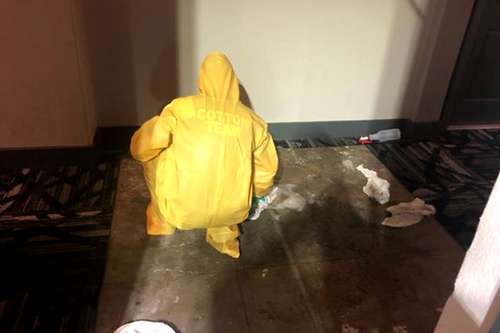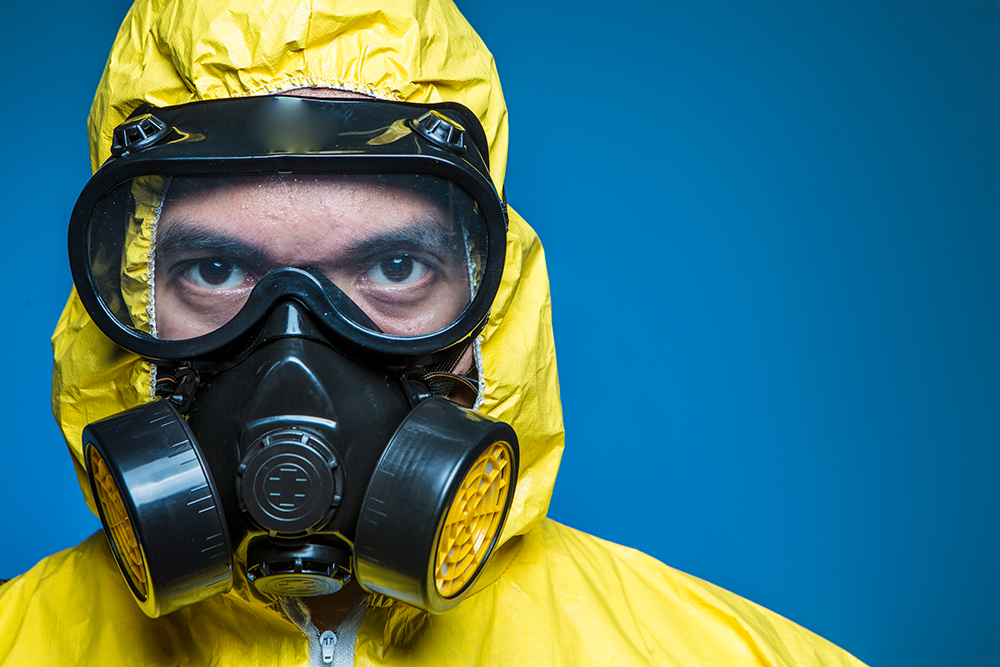Sewage Cleanup Providers: Fast and Safe Remediation of Contaminated Areas
Sewage Cleanup Providers: Fast and Safe Remediation of Contaminated Areas
Blog Article
Specialist Biohazard Cleansing and Decontamination for Blood, Bodily Fluids, and Hazardous Products
The potential wellness dangers connected with exposure to biohazards emphasize the important demand for meticulous handling and complete clean-up. As we browse the intricate landscape of biohazard clean-up, understanding the subtleties of regulations, conformity, and the customized devices at play becomes critical in guaranteeing a secure and comprehensive decontamination process.
Wellness Threats of Biohazard Direct Exposure
Direct exposure to biohazards poses considerable wellness risks that can result in extreme consequences for people and areas alike. Biohazards encompass a large range of organic compounds, including blood, physical liquids, mold, germs, infections, and various other potentially transmittable materials. When people enter call with these biohazards, whether through crashes, incorrect handling, or environmental direct exposure, they deal with the threat of having significant ailments or diseases.
Among the key health and wellness risks linked with biohazard direct exposure is the transmission of infectious diseases. Bloodborne microorganisms such as HIV, hepatitis B and C, and various bacteria can be existing in biohazardous materials, presenting a direct threat to human health. Inhaling air-borne biohazards like mold and mildew spores or coming right into contact with polluted surface areas can also bring about breathing concerns, allergic reactions, and other negative health and wellness impacts.
Moreover, biohazard direct exposure can have long-lasting wellness implications, with some illness showing up years after the first get in touch with (Blood Cleanup). Consequently, it is crucial to focus on correct biohazard cleaning and purification to reduce these wellness dangers and guarantee the security of people and areas

Specialized Educating for Biohazard Cleanup
When it pertains to dealing with biohazard cleanup successfully and safely, specialized training plays an essential duty in making certain correct purification procedures are adhered to. Biohazard clean-up needs details expertise and skills to successfully reduce risks related to bloodborne pathogens, physical liquids, and harmful materials. Specialists learnt biohazard cleaning go through rigorous guideline on how to safely take care of, eliminate, and get rid of biohazardous products to stop contamination and exposure.
Specialized training for biohazard cleanup covers a variety of crucial subjects, consisting of correct individual safety tools (PPE) usage, bloodborne pathogen recognition, decontamination methods, and dangerous waste disposal procedures. People learnt biohazard cleaning are geared up with the essential experience to evaluate contamination levels, identify prospective threats, and execute ideal clean-up treatments in conformity with regulatory standards.
Constant training and education are paramount in the field of biohazard cleaning to stay updated on the most up to date purification innovations, security procedures, and guidelines. By investing in specialized training, biohazard cleaning specialists can effectively reply to emergency cleanup situations and protect both public health and wellness and the setting.
Value of Proper Purification Strategies
Utilizing proper decontamination techniques is vital in biohazard clean-up to effectively remove harmful products and reduce health threats. Efficient purification not only makes certain the elimination of noticeable traces of blood, bodily liquids, and other biohazards yet also targets unnoticeable virus that may pose major health and wellness hazards otherwise properly removed. By complying with strict decontamination protocols, educated experts can dramatically reduce the risk of exposure to unsafe microbes, infections, and microorganisms that could lead to infections or diseases.
Correct decontamination techniques include the use of specialized devices and anti-bacterials that are particularly developed to reduce the effects of biohazards properly. Comprehensive cleaning and sanitation of polluted areas are important to prevent the spread of pathogens and guarantee a risk-free atmosphere for residents. In addition, the correct disposal of biohazardous waste following purification procedures is important in preventing contamination of various other surface areas or individuals.

Devices and Tools for Safe Cleaning
When dealing with blood, physical liquids, or unsafe materials, biohazard cleansing professionals count on specialized equipment to reduce direct exposure dangers and completely decontaminate the damaged area. In addition, biohazard cleansing sets consisting of anti-bacterials, absorbent products, and biohazard bags are made use of to securely contain and get rid of of infected products.
Advanced cleaning devices like hospital-grade anti-bacterials, HEPA-filtered vacuums, and fogging devices are utilized to sanitize surfaces and eliminate biohazards properly. Specialized tools such as sharps containers and biohazard waste disposal bins are used to securely handle sharp objects and biohazardous waste products. By using the best tools and tools, biohazard cleansing specialists can make certain a complete clean-up procedure that focuses on safety and lessens health and wellness threats for both employees and owners of the damaged room.
Rules and Compliance in Biohazard Cleansing
Correct adherence to laws and conformity standards is vital in biohazard cleansing to ensure the security of both workers and the atmosphere. Government firms such as OSHA (Occupational Safety and Wellness Administration) and the EPA (Epa) have established you can try this out particular guidelines for biohazard clean-up procedures to minimize wellness dangers and ecological contamination. These guidelines cover a range of elements consisting of the handling, transportation, and disposal of biohazardous products, along with the necessary training and safety tools required for workers associated with the cleaning procedure.
Biohazard cleaning firms should stay current with these laws to guarantee that their operations meet the needed safety standards. Failing to adhere to these policies can lead to extreme consequences, including fines, lawsuit, and threatening the health of individuals and crime scene cleanup technician salary the setting. By adhering to stringent regulations and conformity measures, biohazard cleaning business can successfully alleviate threats and make sure a risk-free and comprehensive cleaning process for all celebrations entailed.
Final Thought
In verdict, biohazard cleaning and purification need specific training, appropriate methods, and adherence to policies. Direct exposure to blood, bodily liquids, and harmful materials postures significant wellness threats, making it essential to utilize the appropriate equipment and tools for secure cleaning. By adhering to stringent protocols and guidelines, specialists can successfully mitigate the dangers associated with biohazard direct exposure and ensure the safety of both themselves and others.
As we browse the detailed landscape of biohazard clean-up, comprehending the subtleties of laws, compliance, and the customized equipment at play comes to be critical in ensuring a risk-free and comprehensive decontamination process. (Blood Cleanup)
When it comes to dealing with biohazard clean-up efficiently and securely, specialized training plays an essential duty in making sure proper decontamination procedures are adhered to.Making use of appropriate decontamination strategies is vital in biohazard clean-up to successfully reduce and get rid of hazardous materials health and wellness threats. In addition, biohazard cleansing sets consisting of disinfectants, absorptive materials, and biohazard bags are made use have a peek here of to securely get rid of and contain of contaminated products.
Government companies such as OSHA (Occupational Safety And Security and Wellness Management) and the EPA (Environmental Defense Company) have established particular guidelines for biohazard cleaning procedures to decrease health and wellness threats and ecological contamination.
Report this page